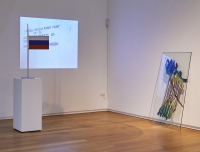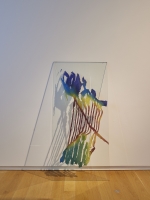Cold Rush
Research on the subject of Arctic sovereignty.
The Hugh Lane Gallery of Art, Sep 2017- Jan 2018
Commissioned work for The Ocean After Nature group show
The Arctic, which is believed to contain as much as one-quarter of Earth’s undiscovered oil and gas, is part of a territorial dispute involving Russia, Canada, Denmark, Norway and the United States. Under a 1982 United Nations convention, the Law of the Sea, a nation may claim an exclusive economic zone over the continental shelf abutting its shores. In 2016 Russia presented its claim to 1.2 million square kilometres of Arctic sea shelf to the United Nations. Canada, Norway and Denmark filed similar claims and, though the Arctic has traditionally been a low military priority, these countries have all stepped up their military activity in what were once icy backwaters on the top of the world.
Unlike the Antarctic, which belongs to no one and is governed by international treaty, the Arctic is up for grabs, and the eight countries that ring the region — Russia, Finland, Sweden, Norway, Iceland, Denmark, Canada, and the United States — have grown increasingly assertive, holding military exercises, reopening nearby Cold War-era bases and building new ones. For example Canada is establishing what it calls northern operations hubs, which will allow sustained operations in the Arctic by 2018, while Russia has invested heavily and established six new bases north of the Arctic Circle.
It’s now being called the new “Great Game,” but the 21st-century cold rush to the Arctic began more than 150 years ago when England sent explorers to look for a North West Passage and to take possession, through symbolic appropriation, of any land they stumbled upon. Three recent events have accelerated interest in the Arctic: global climate change in region and the melting of sea ice; the promise of extraordinary economic gain from ocean-floor resources such as fossil fuels and minerals and from global shipping across open Arctic waters; and finally, the regulations of the 1982 UN Convention on the Law of the Sea. The response of the different participants to these three processes—has a lot to do with each country's historic relationship to the Arctic region.
Through video, sculpture and installation works, I examine the principles concerned with the acquisition and exercise of sovereign rights over the Arctic. The video, Cold Rush (11 mins), which was partly shot at the abandoned RCMP post at Dundas Harbour and at Grise Fiord, Ellesmere Island in the high Arctic in August 2017, explores how national claims to this territory have been founded upon symbolic gestures and seemingly trivial acts, such as setting up a pillar or erecting a cross, raising a national standard and recording in a signed document the ceremony performed as well as the physical movement of people. A key element of the work is an exact replica of the Russian flag which was planted 14,000 feet below the ice on the Arctic seabed in 2006.
Oversized translucent hanging cloths of scrambled arctic military installations slightly block the viewers line of vision and pathway to the works.

